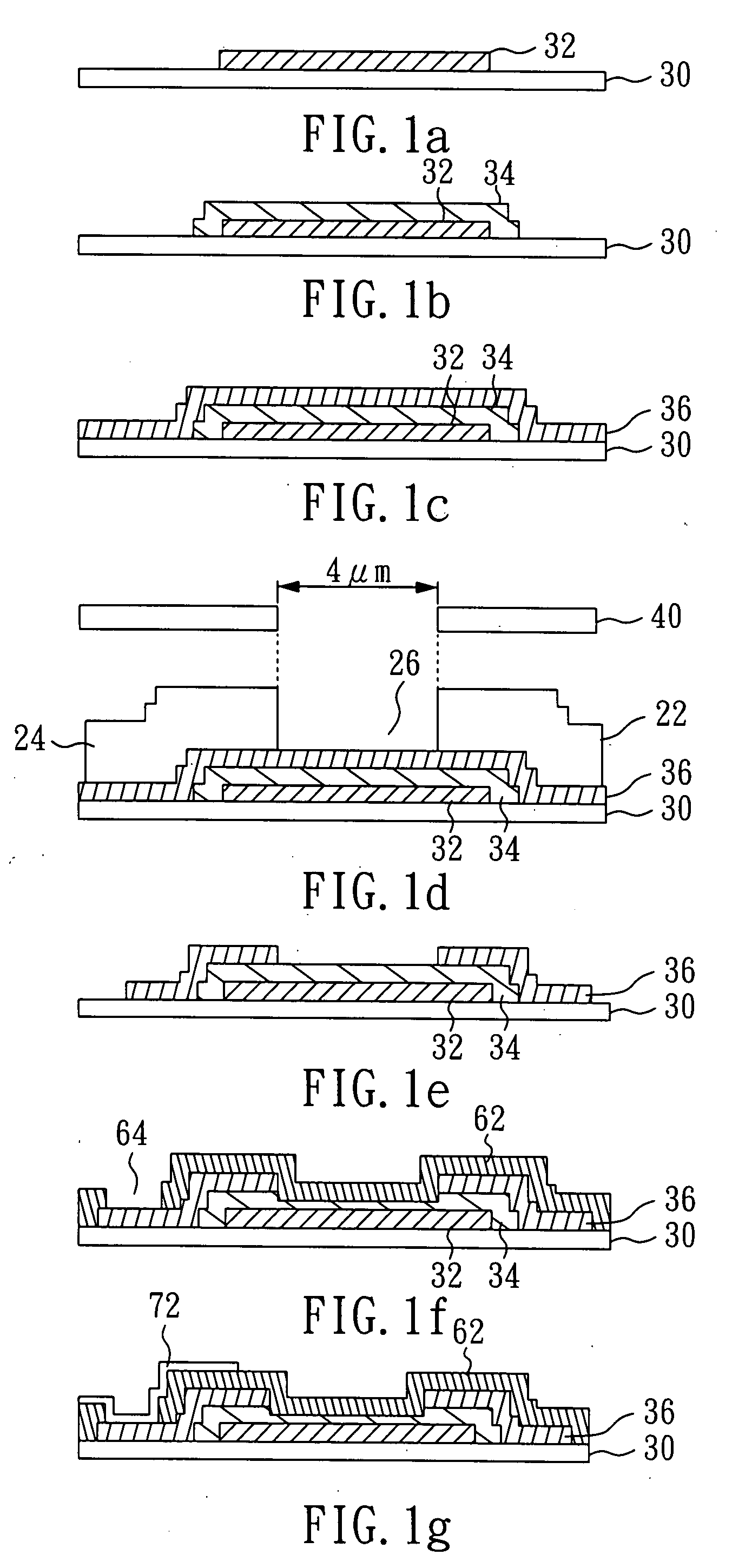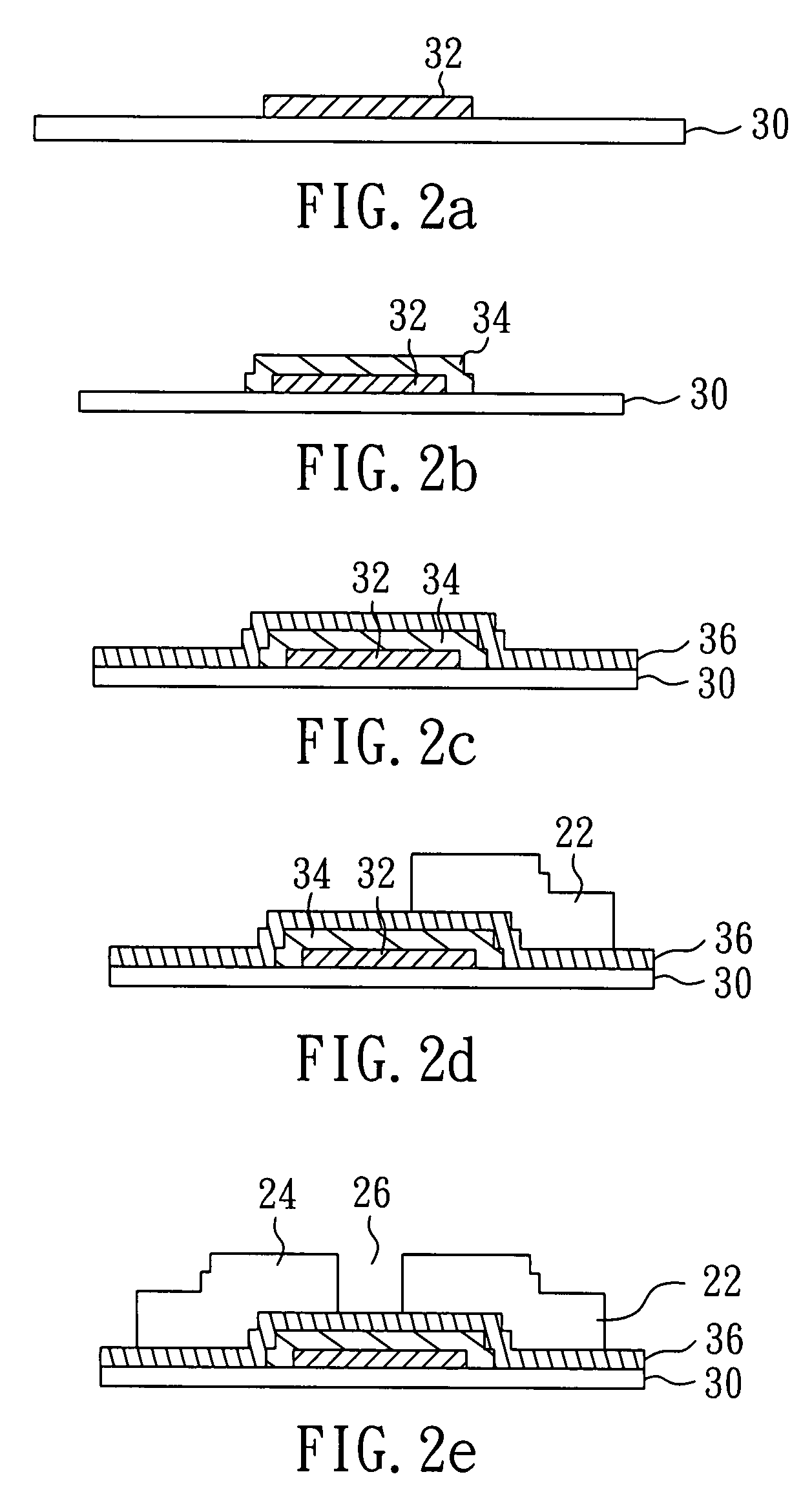Method for manufacturing thin film transistor
a thin film transistor and manufacturing method technology, applied in the direction of electrical equipment, semiconductor devices, instruments, etc., can solve the problems of unsolved exposure processes in use for a considerable time, the enlargement of the tft component area, and the inability to obtain the desired pattern in the large-scale panel. , to achieve the effect of increasing the ion current of the tft, reducing the l-shaped channel length of the tft, and relatively reducing the l-shaped
- Summary
- Abstract
- Description
- Claims
- Application Information
AI Technical Summary
Benefits of technology
Problems solved by technology
Method used
Image
Examples
embodiment 1
[0053]With reference to FIGS. 2a to 2h, there is shown a flowchart in a perspective view of the method in Embodiment 1 of the present invention.
[0054]As shown in FIG. 2a, first, a substrate 30 is provided. The substrate 30 can be a glass substrate, a quartz substrate, or a plastic substrate. Subsequently, in a step of forming a first pattern, a patterned first metal layer 32, as a gate of the TFT, is formed on the substrate 30. The first metal layer can be made of Al, W, Cr, Cu, Ti, TiNx, Al alloy, Cr alloy, or Mo, and it can be a single-layered structure, or a multiple-layered structure.
[0055]As shown in FIG. 2b, a step of forming a second pattern is performed. A patterned semiconductor layer 34 is formed on the patterned first metal layer 32, especially covering the patterned first metal layer 32 for example. The patterned semiconductor layer 34 can be made of amorphous silicon (α-Si).
[0056]As shown in FIG. 2c, a second metal layer 36 is formed on the patterned semiconductor layer...
embodiment 2
[0065]With reference to FIG. 3a to FIG. 3h, there is shown a flowchart in a perspective view of the method in Embodiment 2 of the present invention. The processes in the present embodiment basically are similar to those in aforementioned Embodiment 1, and the differences therebetween are illustrated hereinafter.
[0066]As shown in FIG. 3a, first, a substrate 30 is provided. The substrate 30 can be a glass substrate, a quartz substrate, or a plastic substrate. Subsequently, in a step of forming a first pattern, a patterned first metal layer 32, as a gate of the TFT, is formed on the substrate 30. The first metal layer can be made of Al, W, Cr, Cu, Ti, TiNx, Al alloy, Cr alloy, or Mo, and it can be a single-layered structure, or a multiple-layered structure.
[0067]As shown in FIG. 3b, an insulation layer 31, a semiconductor layer 34, an ohm contact layer 33, and a second metal layer 36 are formed in sequence on the patterned first metal layer 32. The insulation layer 31 can be made of Si...
embodiment 3
[0076]With reference to FIG. 4a to FIG. 4i, there is shown a flowchart in a perspective view of the method in Embodiment 3 of the present invention. The processes in the present embodiment basically are similar to those in aforementioned Embodiment 1, and the differences therebetween are illustrated hereinafter.
[0077]As shown in FIG. 4a, first, a substrate 30 is provided. The substrate 30 can be a glass substrate, a quartz substrate, or a plastic substrate. Subsequently, in a step of forming a first pattern, a patterned first metal layer 32, as a gate of the TFT, is formed on the substrate 30. The first metal layer can be made of Al, W, Cr, Cu, Ti, TiNx, Al alloy, Cr alloy, or Mo, and it can be a single-layered structure, or a multiple-layered structure.
[0078]As shown in FIG. 4b, a step of forming a second pattern is performed. A patterned semiconductor layer 34 is formed on the patterned first metal layer 32. The patterned semiconductor layer 34 can be made of amorphous silicon (α-...
PUM
 Login to View More
Login to View More Abstract
Description
Claims
Application Information
 Login to View More
Login to View More - R&D
- Intellectual Property
- Life Sciences
- Materials
- Tech Scout
- Unparalleled Data Quality
- Higher Quality Content
- 60% Fewer Hallucinations
Browse by: Latest US Patents, China's latest patents, Technical Efficacy Thesaurus, Application Domain, Technology Topic, Popular Technical Reports.
© 2025 PatSnap. All rights reserved.Legal|Privacy policy|Modern Slavery Act Transparency Statement|Sitemap|About US| Contact US: help@patsnap.com



